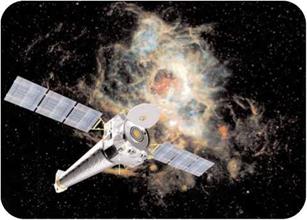Communications Satellites
Telecommunications providers use communications satellites (comsats), which function as relays for telephone, radio, and television signals. The first satellite able to relay a voice signal was launched in 1960; Telstar was the first real communications satellite, launched in 1962. Syncom 3, launched in geostationary orbit in 1963, relayed the 1964 Tokyo Olympics to U. S. viewers, the first television pictures sent across the Pacific Ocean. Intelsat 1, also known as “Early Bird,” relayed TV signals across the Atlantic in 1965. Satellites launched for commercial companies revolutionized satellite and cable TV. They made satellite television possible-today there are hundreds of channels, and live coverage of events is transmitted all over the world. Groups of satellites also provide worldwide phone networks.
Military comsats such as the U. S. Milstar system (launched in 1994) provide secure communications that cannot be blocked. In the 1960s, the Russians launched a series of Molniya comsats into elliptical, 12-hour orbits, with perigees (low points) of no more than a few hundred miles and apogees (high
О Geostationary operational environmental satellites (GOES) provide views of Earth that help forecasters accurately predict emergency weather conditions. This GOES image shows Hurricane Andrew over the Gulf of Mexico in 1992.
|
О Chandra, named for a leading Indian astrophysicist, Subrahmanyan Chandrasekhar, is one of the largest satellites ever. It carries eight mirrors to focus X-rays from distant objects, a high-resolution camera, and a spectrometer to measure the amount of energy in the X-rays. |
points) of up to 25,000 miles (40,230 kilometers). This kind of orbit is now called a Molniya orbit. Less rocket power is needed to put a satellite into this orbit than into a high geostationary orbit.











